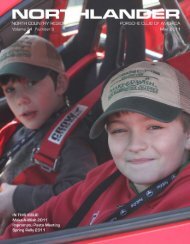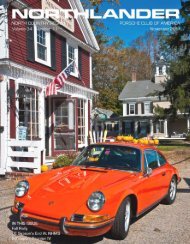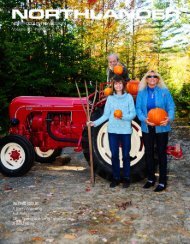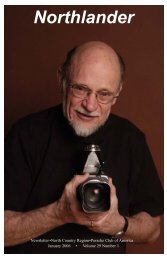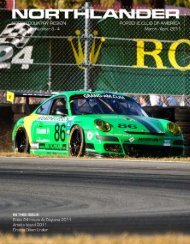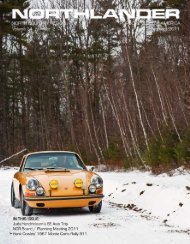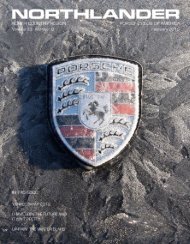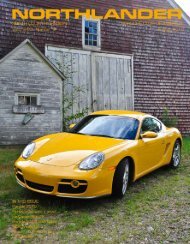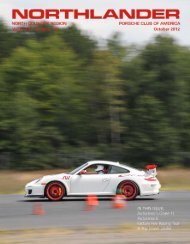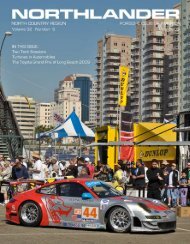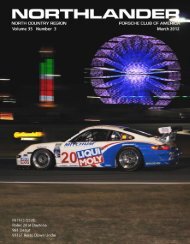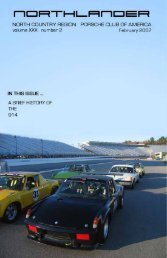1 Northlander March 2013 - North Country Region
1 Northlander March 2013 - North Country Region
1 Northlander March 2013 - North Country Region
Create successful ePaper yourself
Turn your PDF publications into a flip-book with our unique Google optimized e-Paper software.
Rich Willey<br />
Where The Rubber Meets The Road<br />
Some of you loyal <strong><strong>North</strong>lander</strong> readers know I made the pilgrimage to Watkins Glen in 2012 for the Zone 1 48 hr. DE event.<br />
During some down time I wandered over to the Glen store and bought some too-expensive tee shirts and a book written by<br />
Michael Argetsinger, the son of Cameron Argetsinger who was President of the Watkins Glen Grand Prix Corporation in the 60s<br />
and 70s. It brought back many memories and provided information I had either forgotten or never knew. I’d like to share some<br />
of the highlights of those twenty years.<br />
Tidbits.<br />
-The pit lane/start finish line was on the short straight between what is now turns 1 and 2. When you exit the pits today taking<br />
the right down the access road parallel to the track, you are sort of driving down the old pit lane just before you enter the track<br />
before turn 2. As you know if you have been there, this is down-hill. Since F1 cars don’t have e-brakes, they had to use stones<br />
or bricks in front of the tires when in the pits to keep ‘em from rolling away should they slip out of gear.<br />
- There were no garages at WG in the early days, so teams would rent space at local car dealerships or local mechanic’s garages<br />
in the village of Watkins Glen and truck the cars up the hill to the track in open trailers each day. Ferrari continued to do that<br />
long after a garage was built at the track so the competition couldn’t get an early look at their car set-ups.<br />
- Until advertising became a major force in racing, F1 cars were painted specific colors representing their country. British teams<br />
were British Racing Green (BRG) and distinguished one from the other with accent colors. Lotus was yellow, BRM had red nose<br />
rings, etc. French cars (Matra) were light blue, Ferrari was of course red, German cars were silver or white. Later Japanese<br />
cars (Honda and much later Toyota) were white. The independent teams chose whatever colors they fancied. McLaren’s were<br />
bright orange. The lone American F1 effort from Dan Gurney’s All American Racing (AAR) was dark blue with white accents. (It<br />
is arguably the most stunning F1 car of all time and your writer had the privilege of seeing it up close at a vintage F1 race about<br />
12 years ago at Indy)<br />
-The US Formula 1 Grand Prix took place at Watkins Glen between 1961 and 1980. Prior to that it had been run at Sebring in<br />
1959 and Riverside in 1960. From 1958-1960 there was a Formula Libre race at WG, not an official F1 event. While drivers such<br />
as Sterling Moss, Dan Gurney and Jo Bonnier participated, there were rarely any true F1 cars in the field which mostly included<br />
sports cars and even midgets.<br />
-The 1961 race only happened at the last minute. The US GP promoter, Alec Ulmann had a 3 year option and after disastrous<br />
financial results in 1959 and 1960 he was determined to succeed in his 3rd year. Casting about for a venue he struck a deal with<br />
Cam Argetsinger 6 weeks before the race date which was in early October. Typically the foliage was magnificent that time of<br />
year but I can attest to the fact that there was often ice each morning on the pools of water in the camp grounds.<br />
- Interest in the 1961 race was considerable. Phil Hill, an American would be in position to win the world championship at Watkins<br />
Glen, as he dueled fellow team driver Wolfgang von Tripps in the new 1.5 liter Ferrari. But we all know what happened!! von<br />
Tripps died at Monza killing 12 spectators and Ferrari withdrew from F1. Phil Hill would be crowned world champion at the end<br />
of the season, but he was without a ride for Watkins Glen. Bonnier and Gurney drove the Porsche F1 entries and Innes Ireland<br />
won in a Lotus.<br />
- Ford was the official car of Watkins Glen and in 1962 the Mustang concept car was unveiled and used as sort of a pace car.<br />
Sterling Moss was the grand marshal as he had been injured earlier that year at Goodwood, ending his racing career. Jim Clarke<br />
won in 1962 in a Lotus 25, the first F1 car to use a monocoque chassis<br />
continued fron page 12 ...<br />
<strong>March</strong> <strong>2013</strong><br />
9 <strong><strong>North</strong>lander</strong>




